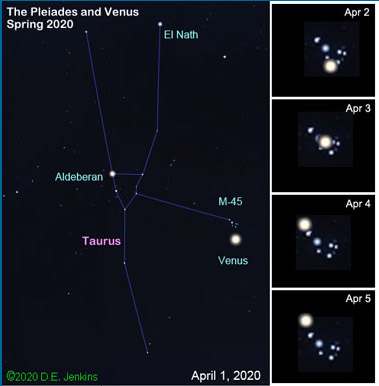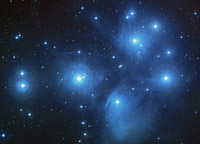
March 2020 - Vol. 24, No. 3
This Month's Night Sky - NOTE: The next paragraph describes the sky as it appears at 10 pm EST (11 pm EDT) near mid- month. The sky also looks this way at 11 pm EST (midnight EDT) during the beginning of the month and at 9 pm EST (10 pm EDT) by month's end.
The constellations Taurus, with its Pleiades (a tiny "dipper-like" asterism), Orion and the Winter Triangle are now sinking in the W. Castor and Pollux (the Gemini "twins") are shining in the NW while Capella (Auriga) glows above them. Regulus (Leo) shines high in the S as the wandering constellation Hydra appears to create a void below since it has no bright stars. The "Big Dipper" asterism (Ursa Major) high in the NE has appeared to "rotate" so its "handle" is now nearly horizontal. Spica (Virgo) and Arcturus (Bootes) are now rising in the E. Spring is coming!
MERCURY is in the morning sky favors southern observers. VENUS in the evening sky favors northern observers, reaching -4.4 mag by month's end. MARS in the morning sky, as the month begins is located in Sagittarius with Jupiter and Saturn. As the month progresses the red planet will overtake both gas giants, see the almanac below for the dates of conjunction as Mars speeds away from the outer planets this year. JUPITER shines in the morning sky. SATURN joins Jupiter in the early morning sky. URANUS sets well before mid-night. NEPTUNE disappears in the evening twilight sky heading for conjunction with the Sun.
Review how to determine Angular Measurement.
Calendar of Events
NOTE: For those observers not in the ET zone, convert the calendar times to your zone's time by subtracting one hour for CT, two for MT and three for PT. Don't forget to adjust for Daylight Savings Time when necessary by subtracting one hour from your planisphere's time. Dawn and dusk times must also be corrected. See your local newspaper, TV news, or cable TV's Weather Channel for sunrise and sunset times or check with the U.S. Naval observatory. Unfortunately some of these events may occur during daylight hours in your area.
| DATE | EVENT |
| 01 | Vesta 0.1 deg, N. of Moon, occultation from Australia, E. Indonesia, NW Melanesia, Micronesia, and Hawaii. |
| 04 | Moon 1.2 deg S. of M-35 star cluster. |
| 06 | Moon 1.1 deg N. of M-44 (Beehive) star cluster. |
| 08 |
Daylight Savings Time begins. Neptune in conjunction with the Sun. |
| 09 | Mercury stationary. Venus 2 deg. N. of Uranus This month's full moon will be the largest full moon of the year as the moon is very close to perigee. This moon is nicknamed the "Worm" moon or "Full Sap" moon referring to sugar maple trees that are tapped at this time. It may be hard to tell the difference visually between this moon and one that occurs when the moon is farther from the Earth. This year there are 3 full moons that occur near perigee look for them in April and May. |
| 10 | Moon at perigee, expect large tides. |
| 11 | Look W from a dark location, at about an hour after sunset, to view zodiacal light. ("Zodiacal light" is a vertical band of white light believed to be sunlight reflected from meteoroids found in the plane of the ecliptic, the apparent "path" of the Sun, Moon and Planets as they travel across our sky.) It will appear to be a very large, but very dim, pyramid of of white light, "leaning" to the left. This effect may be visible for the next two weeks on dark nights. |
| 18 |
Mars 0.7 deg. N. of Moon, occultation from S. South America, Antarctica, and Kerguelen Islands. Jupiter 1.5 deg. N. of Moon. Pluto .9 deg N. of Moon, occultation from most of Antarctica. |
| 19 | Saturn 2 deg. N. of Moon. |
| 20 | Equinox, the sun rises due East, sets due West. Mars 0.7 deg. S. of Jupiter. Venus at perihelion. |
| 21 | Mercury .4 deg. N. of Moon. |
| 24 |
Mercury at greatest elongation W. (28 deg.) Moon at apogee. Venus greatest elongation E. (46 deg.) |
| 26 | Uranus 4 deg. N. of Moon |
| 27 | Mercury at aphelion. |
| 28 | Venus 7.0 deg. N. of Moon. |
| 29 | Vesta 0.2 deg. N. of Moon occultation from S. Indian Ocean, Indonesia, parts of SE Asia, Philippines, Micronesia, N Polynesia (not Hawaii). |
| 31 |
Mars 0.9 deg. S. of Saturn. Moon 0.9 deg S. of M-35 star cluster. |
Lunar Almanac for March 2020
| Phases of the Moon | Phase and Date(s) | Best viewed before local midnight |
 |
New 24 |
Deep Space Objects |
 |
1st. Qtr 02 |
Planets & Moon |
 |
Full 09 |
Moon |
 |
Last Qtr 16 |
Deep Space & Planets |
Topic of the month: Venus visits the Pleiades
This year, the bright planet Venus has been dazzling the northern hemisphere with her brilliant light. If you have been outside in the evening, you've probably seen it. As soon as the Sun sets, the magnificent planet Venus has been towering over the western horizon. This northern passage is not unusual, it is part of the regular cycle that repeats between Earth and Venus every 8 years. Because Venus and Earth are neighbors, it's no mistake that Venus is the brightest planet in our sky. Her magnificent brilliance can also be attributed to the fact that the surface is entirely cloud covered. On March 24, Venus will be at its createst elongation from the Sun (commonly abbreviated GE.) At this time the planet is as far away from the Sun as can be seen from Earth. Venus is 47 degrees away from the Sun on that date, but soon begins heading toward the horizon.
This northern apparition of Venus began in November 2019 when the planet was moving into Capricornus, crossing the sky through Aquarius, Pisces, and Aries all the while hovering over the western horizon. Finally reaching the constellation of Taurus, known as the bull. This constellation is the home of the bright first magnitude star Aldebaran, that is connected to the Hyades star cluster by line of sight only. Some saw the Hyades star cluster as the jaw or face of the bull. It is the closest star cluster to the Earth, but Aldebaran is closer to us still.

In April 2020, the planet Venus makes a visit to the bright star cluster M-45, commonly known as the Pleiades. Located in the constellation of Taurus, this group of stars is said to have seven bright members, sometimes referred to as the Seven Sisters. One of the best known clusters in the sky, the stars were formed around the same time. They are shrouded in the wispy nebulosity that reflects their light and can even be noticed with the unaided eye.
This year's visit of Venus to the Pleiades begins around the first of April when our sister planet moves close to the cluster as seen in the large frame. This outline of Taurus and images come with the open source astronomy software program Stellarium that is often used at this site. If the sky is clear in the last few days of March, take a look at the sky and see how close Venus is to the M-45 cluster.
It is interesting that they are called the "seven" sisters, because most people can only see six of the cluster's 3,000 members without optical aid. This has given rise to a legend of a lost Pleiad. The brightest star is Alcyone (mag 2.9), the third brightest star in the constellation. The second brightest Pleiad is Atlas (mag 3.62) The other sisters are fainter, called Merope, Calaeno, Taygeta, Sterope, Electra, and Maia. Actually, there are some that aren't too hard to see, but they are located away from the main bright stars.

Many cultures in the northern hemisphere marked the Spring setting of the Pleiades as a time to begin planting for the new year. The Pleiades cluster was of great interest to Aztecs who marked the midnight culmination of the cluster they called "Tiānquiztli." The Sumerians called them Mul-mul, a name that means, "star star." The Akkadian name was "zappu" or "bristle", sometimes thought of as "hair brush." Although "western" astronomers thought of the stars poetically as sisters, in Mesopotamian reckoning, these were the "seven demons" and their name was at times given to the planet Mars who was the ultimate "bad boy" planet in their celestial divinations. These demons were known as "Sebetti" or "Sibitti."
(Pleiades Image provided by NASA, ESA, AURA/Caltech, Palomar Observatory)
The Virtual Telescope Project is offering an online observing session on April 3, 2020. Check it out if the sky by you is cloudy. If the sky is clear for you on that date, start checking as soon as the Sun sets. For the next few hours, Venus will close in on M-45 and slowly move back out.
--See You Under the Stars!
Astra for Astra's Almanac
This installment of "What's Up?" is ©2020 by Dawn Jenkins for Astra's Stargate. View Ron Leeseburg's Farewell Issue for information on where to find information such as is presented in this almanac.